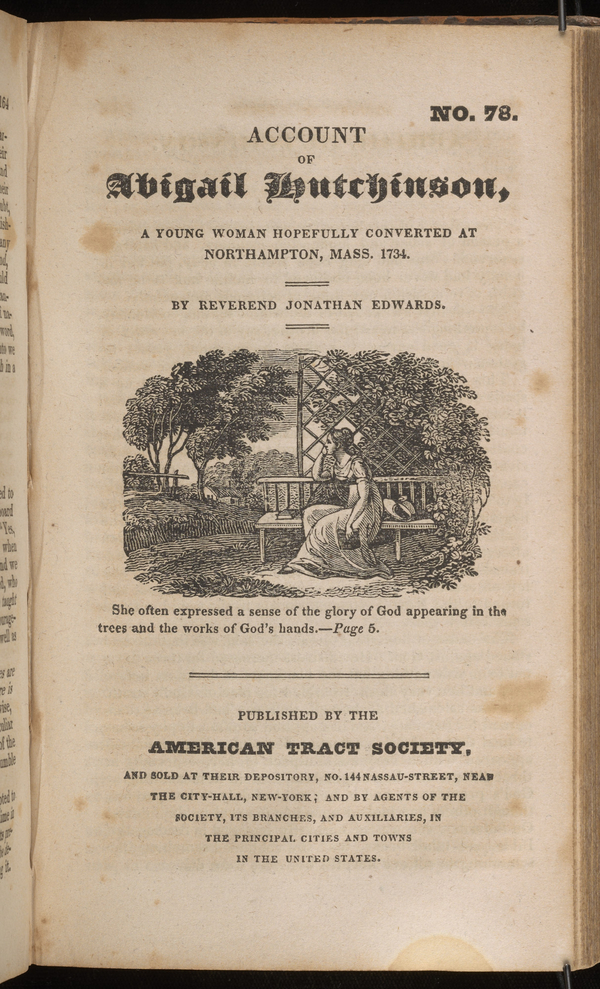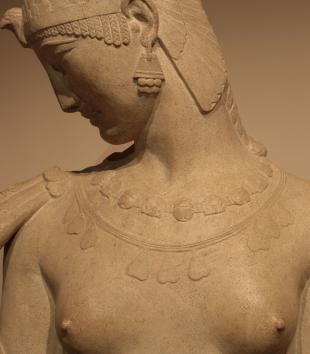That “Protestants don’t have pictures” remains a common generalization. Yet in the early nineteenth century, nothing could be further from the truth. Protestant publishers like the nonsectarian American Tract Society (ATS) lavishly decorated their tracts with small but expressive printed illustrations. Like the above wood-engraved vignette decorating the cover of the ATS’s Account of Abigail Hutchinson—a reissue of the classic conversion narrative written by Puritan divine Jonathan Edwards—many of these were created by the self-taught Alexander Anderson, the first wood engraver in America and the ATS’s most prolific illustrator. In his characteristically bold black-and-white lines, Anderson depicts Abigail as pausing from her scripture reading to gaze out into the lush countryside of Northampton, Massachusetts. Nature whirs into motion. Wind gently bends the trees and shadows suggest an afternoon sun sinking low beyond the frame. Abigail’s reverent countenance indicates her appreciation for divine creation in all its glory. It was images like this one that served as indispensable media of evangelization in an increasingly crowded religious marketplace. They preached a gospel to the eye that was didactic but also aesthetically and emotionally engaging.
It is essential to understand religious wood engravings like Anderson’s Abigail as products of their particular technological moment. The technology of wood engraving, originally developed in England in the late eighteenth century, required a refined tool such as a burin to incise in relief on the close-grained end of a hard wood, usually boxwood. (It differed from its ancestor the woodcut, which is chiseled instead on the long softer side of a block, parallel to the grain.) Given its economical advantages over copperplate engraving, wood engraving soon rose to dominance in early nineteenth-century America as a means of visual reproduction before the advent of lithography and photography. As the ATS intentionally instrumentalized this visual technology to suit their needs, the technology itself—that is, its specific material capability—worked to structure Protestant visual engagement in three ways.
First, wood engraving allowed for word and image to be printed alongside one another on a single page at the same time. Unlike the copper plates used in contemporaneous printing methods, wood engraving blocks could be milled to the same thickness as type and then printed concurrently with it. The possibility of streamlined, low-cost textual integration appealed to Protestants who intended visual delights to catalyze acceptance of the tract’s saving textual content. Indeed, Anderson’s Abigail is not presented as an autonomous image. Rather it abuts a direct quote, with a page reference, from the body of the tract: “She often expressed a sense of the glory of God appearing in the trees and the works of God’s hands.” Wood engraving allowed text and image to complete—rather than to compete with—one another.
Second, wood engravings were usually miniatures by material necessity. Boxwood is a narrow tree, so engravings made on its hard end could rarely be much larger than today’s business cards.1 Small images were less likely to appear ostentatious and were consequently unsuitable for idolatry, proving less threatening to Protestants with an iconophobic streak. Such a scale also invited personal viewing. If the altarpiece represents the visual equivalent of a shout, the miniature may be compared to a whisper. To see miniatures properly, a viewer must incline his or her body and gaze toward the image much in the same way that whispering requires a listener to incline towards the speaker. Such an individualized relation between body and image resonated with early-nineteenth-century Protestantism’s emphasis on interiority.
Third, wood engravings offered Protestants the perfect imagistic medium for mass evangelization. Wood was cheaper than copper, so publishers could commission more images at a lower cost. Hardwood presented another key advantage over copper for publishers concerned with quantity in that it was far more resilient and could be printed with lower pressure, delaying block deterioration and enduring the printing of dramatically longer editions than ever before possible. While soft copper plates yielded a couple thousand copies at best, end-grain wood blocks allowed for several hundred thousand runs each.
The Abigail woodblock’s durability afforded it a long and dynamic career. Though precise dating remains difficult, it is likely that Anderson first created the block in 1826 for the tract’s first illustrated edition, printed by the ATS in New York. Later that year, the Society probably lent out the block to its Boston-based affiliate, which repurposed it to decorate a different tract altogether, the Reflections on the Seven Days of the Week by Catharine Talbot; in this new context, Abigail was simply refigured as Catharine. The New York-based Society then printed several further illustrated editions of Account of Abigail Hutchinson through at least 1840, both as separate leaflets and bound in larger volumes. This specific example was bound as “no. 78” in Volume III of the Society’s nine collections of tracts, likely published between the years 1827 and 1832. The ATS ensured that these many copies were distributed far and wide with its sophisticated colportage system, in which colporteurs peddled tracts across the fledgling nation. Ultimately, these mass production and distribution schemes locate images like Abigail and its technology of wood engraving at the beginnings of mass media in America.
Notes
Notes
1. Later publishers of wood engravings circumvented the medium’s scale constraints by joining together several blocks in a metal frame. Harper and Brothers, for example, used such composite wood engravings to produce the larger images decorating their Illuminated and Pictorial Bible, first published in 1843.
Keywords
Imprint
10.22332/con.obj.2014.38
1. Sonia Hazard, "Alexander Anderson, Abigail Hutchinson: A Young Woman Hopefully Converted," Object Narrative, in Conversations: An Online Journal of the Center for the Study of Material and Visual Cultures of Religion (2014), doi:10.22332/con.obj.2014.38
Hazard, Sonia. "Alexander Anderson, Abigail Hutchinson: A Young Woman Hopefully Converted." Object Narrative. In Conversations: An Online Journal of the Center for the Study of Material and Visual Cultures of Religion (2014). doi:10.22332/con.obj.2014.38




